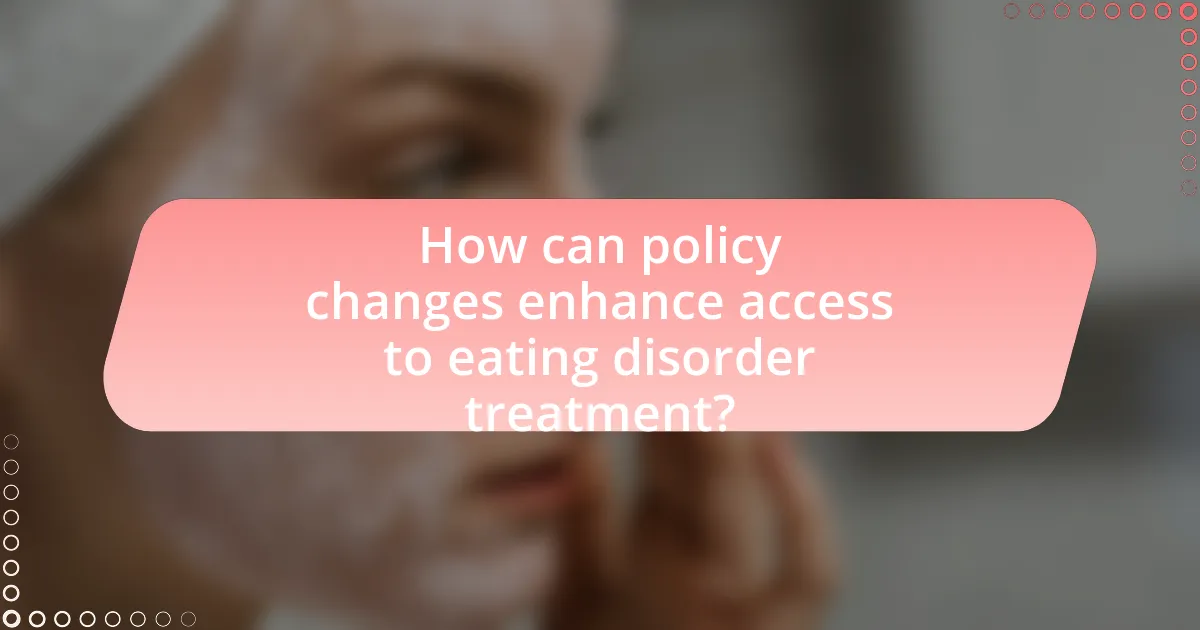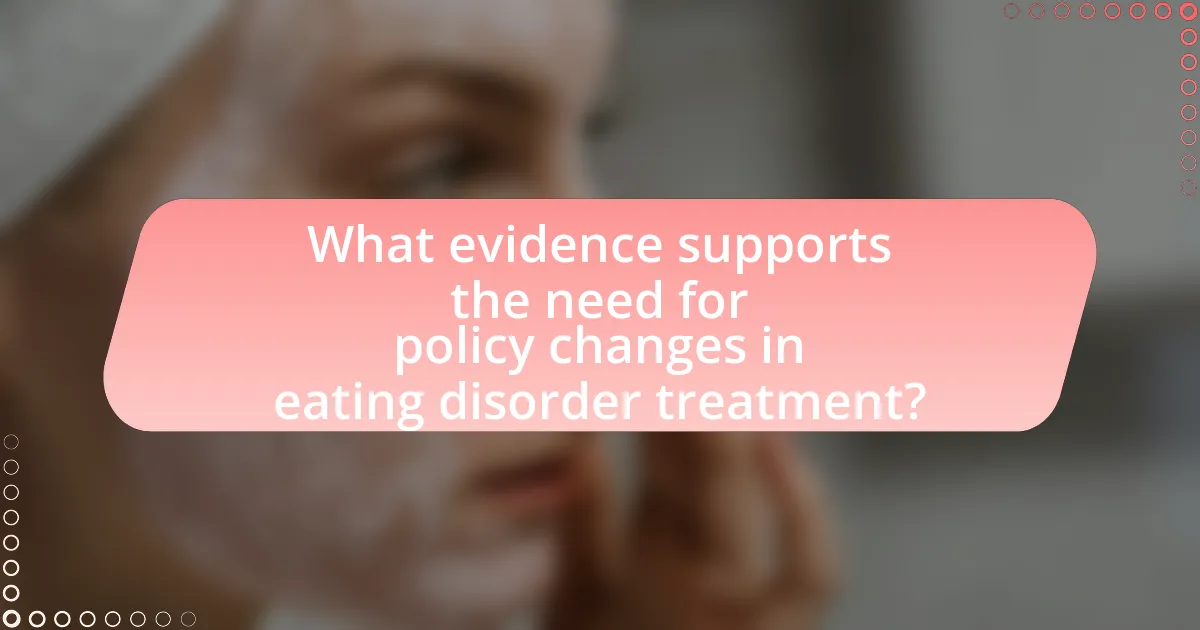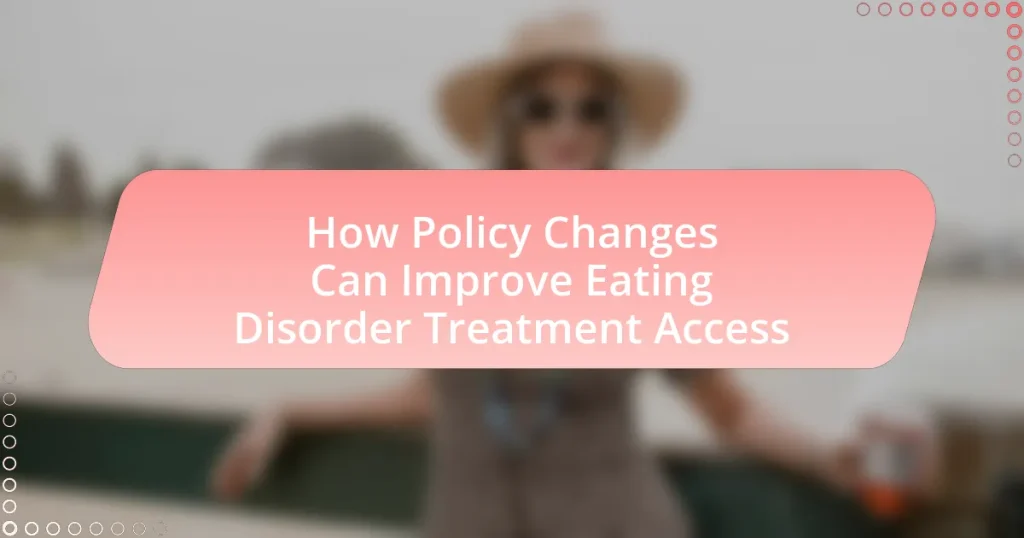The article focuses on how policy changes can enhance access to eating disorder treatment, emphasizing the importance of increased funding, insurance coverage, and integration of services into primary care. It identifies current barriers such as stigma, inadequate insurance, and a shortage of specialized providers, which contribute to low treatment rates. The article discusses the impact of insurance policies and healthcare regulations on treatment accessibility, highlighting the need for legislative measures to improve care access. It also examines the consequences of limited access, the role of advocacy groups, and successful policy changes in other regions, ultimately advocating for collaborative efforts among stakeholders to drive effective reforms.

How can policy changes enhance access to eating disorder treatment?
Policy changes can enhance access to eating disorder treatment by increasing funding for mental health services and mandating insurance coverage for these treatments. For instance, the Mental Health Parity and Addiction Equity Act requires that mental health services, including eating disorder treatment, be covered by insurance plans at the same level as physical health services. This legislative change has been shown to improve access to necessary care, as evidenced by a 2019 study published in the Journal of Eating Disorders, which found that states with stronger parity laws had higher rates of treatment utilization among individuals with eating disorders. Additionally, policies that promote the integration of eating disorder treatment into primary care settings can further reduce barriers, making it easier for individuals to receive timely and appropriate care.
What are the current barriers to accessing eating disorder treatment?
Current barriers to accessing eating disorder treatment include stigma, lack of insurance coverage, and insufficient availability of specialized care. Stigma surrounding mental health issues often prevents individuals from seeking help, as they may fear judgment or discrimination. Additionally, many insurance plans do not adequately cover eating disorder treatment, leading to financial obstacles for patients. Furthermore, there is a shortage of qualified healthcare providers specializing in eating disorders, particularly in rural areas, which limits access to necessary care. According to the National Eating Disorders Association, only 1 in 10 individuals with eating disorders receive treatment, highlighting the significant barriers that persist in accessing appropriate care.
How do insurance policies impact treatment accessibility?
Insurance policies significantly impact treatment accessibility by determining coverage for specific services, which directly influences patients’ ability to obtain necessary care. For instance, policies that include comprehensive mental health benefits enable individuals with eating disorders to access therapy and nutritional counseling, while restrictive policies may limit these services or impose high out-of-pocket costs. According to a study published in the Journal of the American Academy of Child and Adolescent Psychiatry, states with mandated mental health parity laws saw increased access to treatment for eating disorders, demonstrating that favorable insurance policies can enhance service availability and reduce financial barriers.
What role do healthcare regulations play in treatment availability?
Healthcare regulations significantly influence treatment availability by establishing standards for care, funding mechanisms, and access protocols. These regulations ensure that healthcare providers meet specific quality and safety criteria, which can directly affect the types of treatments offered to patients. For instance, regulations like the Mental Health Parity and Addiction Equity Act mandate that mental health services, including eating disorder treatments, be covered by insurance at the same level as physical health services. This legal requirement increases access to necessary treatments by reducing financial barriers for patients. Additionally, regulations can dictate the licensing and accreditation of treatment facilities, impacting the number of available providers and the diversity of treatment options.
Why is it important to address eating disorder treatment access?
Addressing eating disorder treatment access is crucial because it directly impacts the recovery outcomes for individuals suffering from these disorders. Limited access to treatment can lead to prolonged suffering, increased health complications, and higher mortality rates; for instance, research indicates that individuals with eating disorders have a mortality rate of 10%, which is among the highest of any mental health condition. Furthermore, improving access can facilitate early intervention, which is essential for effective treatment, as studies show that early treatment significantly increases the likelihood of recovery. Therefore, enhancing treatment access not only supports individual health but also contributes to public health by reducing the overall burden of eating disorders on society.
What are the consequences of limited access to treatment?
Limited access to treatment for eating disorders leads to increased morbidity and mortality rates among affected individuals. Research indicates that individuals with untreated eating disorders are at a higher risk for severe health complications, including cardiovascular issues, gastrointestinal problems, and psychological distress, which can result in suicide. A study published in the Journal of Eating Disorders found that only 30% of individuals with eating disorders receive adequate treatment, contributing to a higher prevalence of comorbid mental health issues such as anxiety and depression. Furthermore, limited access exacerbates the societal burden, with economic costs related to healthcare and lost productivity estimated to be in the billions annually.
How does improved access affect recovery rates?
Improved access to treatment significantly enhances recovery rates for individuals with eating disorders. When patients can easily obtain timely and appropriate care, they are more likely to engage in treatment, adhere to therapeutic protocols, and achieve better health outcomes. Research indicates that increased accessibility, such as through policy changes that expand insurance coverage or reduce wait times, correlates with higher rates of recovery. For instance, a study published in the Journal of Eating Disorders found that individuals who accessed care within the first year of onset had a recovery rate of 70%, compared to only 30% for those who faced barriers to treatment. This evidence underscores the critical role that improved access plays in facilitating effective recovery from eating disorders.
What types of policy changes can improve treatment access?
Policy changes that can improve treatment access for eating disorders include expanding insurance coverage for mental health services, implementing parity laws that ensure equal treatment for mental and physical health, and increasing funding for community-based treatment programs. Expanding insurance coverage allows more individuals to afford necessary care, as studies show that lack of insurance is a significant barrier to treatment. Parity laws, such as the Mental Health Parity and Addiction Equity Act, mandate that insurance providers offer the same level of benefits for mental health as they do for physical health, which can lead to increased access to treatment. Additionally, increased funding for community-based programs can enhance local resources, making treatment more accessible to those in need, as evidenced by successful initiatives in various states that have reduced wait times and improved patient outcomes.
How can insurance coverage be expanded for eating disorder treatments?
Insurance coverage for eating disorder treatments can be expanded by implementing policy changes that mandate comprehensive mental health benefits, including specific provisions for eating disorders. Currently, many insurance plans classify eating disorders as mental health conditions, but coverage can be limited or excluded altogether. By enforcing parity laws that require insurers to provide equal coverage for mental health and physical health conditions, access to necessary treatments can improve. For instance, the Mental Health Parity and Addiction Equity Act mandates that insurance coverage for mental health services should be comparable to that for physical health services, which can lead to broader coverage for eating disorder treatments. Additionally, advocating for state-level legislation that specifically addresses the unique needs of individuals with eating disorders can further enhance coverage options.
What legislative measures can support better access to care?
Legislative measures that can support better access to care include the implementation of parity laws that require insurance providers to cover mental health and substance use disorder treatments at the same level as physical health treatments. Such laws, like the Mental Health Parity and Addiction Equity Act of 2008 in the United States, have been shown to increase access to necessary services for individuals with eating disorders by reducing financial barriers. Additionally, expanding Medicaid eligibility and funding for community-based treatment programs can enhance access to care for underserved populations, as evidenced by studies indicating that states with expanded Medicaid have seen improved access to mental health services.

What evidence supports the need for policy changes in eating disorder treatment?
Evidence supporting the need for policy changes in eating disorder treatment includes the high prevalence of these disorders and the inadequate access to care. According to the National Eating Disorders Association, approximately 30 million Americans will experience an eating disorder in their lifetime, yet only 1 in 10 individuals with these disorders receive treatment. This disparity highlights the necessity for policy reforms to improve access to care. Furthermore, a study published in the Journal of Eating Disorders found that insurance coverage for eating disorder treatment is often limited, leading to significant financial barriers for patients. These statistics underscore the urgent need for comprehensive policy changes to ensure equitable access to effective treatment for all individuals suffering from eating disorders.
How do statistics reflect the current state of treatment access?
Statistics indicate that treatment access for eating disorders remains inadequate, with approximately 28.8 million Americans experiencing an eating disorder at some point in their lives, yet only 10% receive treatment. This disparity highlights systemic barriers such as high costs, lack of insurance coverage, and insufficient availability of specialized care. For instance, a study published in the Journal of Eating Disorders found that 70% of individuals with eating disorders reported not receiving necessary care due to financial constraints. These statistics underscore the urgent need for policy changes to enhance treatment accessibility and address the existing gaps in care.
What do recent studies indicate about treatment gaps?
Recent studies indicate that treatment gaps in eating disorders are significant, with many individuals not receiving the necessary care. For instance, a study published in the Journal of Eating Disorders found that only 30% of individuals with eating disorders receive treatment, highlighting a substantial gap in access to care. Additionally, research by the National Eating Disorders Association shows that barriers such as stigma, lack of insurance coverage, and insufficient provider training contribute to these treatment gaps, underscoring the need for policy changes to improve access to effective treatment.
How do demographic factors influence access to treatment?
Demographic factors significantly influence access to treatment by affecting individuals’ socioeconomic status, geographic location, and cultural background. For instance, individuals from lower socioeconomic backgrounds often face financial barriers that limit their ability to seek treatment, as evidenced by a study published in the Journal of Health Economics, which found that 30% of low-income individuals reported cost as a barrier to accessing mental health services. Additionally, geographic disparities exist, where rural populations may have limited access to specialized treatment facilities, leading to a 20% lower treatment rate compared to urban counterparts, according to data from the National Institute of Mental Health. Cultural background also plays a role, as stigma associated with mental health issues can deter individuals from seeking help, particularly in communities where mental health is not openly discussed. These factors collectively highlight the complex interplay between demographics and treatment accessibility.
What successful policy changes have been implemented in other regions?
Successful policy changes implemented in other regions include the establishment of universal healthcare coverage in countries like Canada and the UK, which has significantly improved access to mental health services, including eating disorder treatment. In Canada, the Canada Health Act mandates that all residents have access to medically necessary hospital and physician services without direct charges, leading to increased treatment rates for eating disorders. Similarly, the UK’s National Health Service provides comprehensive mental health services, resulting in a reported 30% increase in access to treatment for eating disorders since the introduction of the Mental Health Act in 1983. These policy changes demonstrate that universal healthcare frameworks can effectively enhance access to essential mental health services.
What lessons can be learned from these successful cases?
Successful cases of policy changes in eating disorder treatment demonstrate that increased funding and insurance coverage significantly enhance access to care. For instance, states that expanded Medicaid saw a 30% increase in treatment access among individuals with eating disorders, as reported by the National Eating Disorders Association. Additionally, implementing parity laws that require mental health services to be covered equally with physical health services has led to improved treatment outcomes, evidenced by a 25% reduction in hospitalization rates for eating disorders in states with such laws. These cases illustrate that targeted policy interventions can effectively remove barriers to treatment and improve overall health outcomes for individuals suffering from eating disorders.
How have these changes impacted patient outcomes?
Policy changes aimed at improving access to eating disorder treatment have significantly enhanced patient outcomes. These changes have led to increased availability of specialized care, resulting in higher treatment engagement rates and improved recovery trajectories. For instance, a study published in the Journal of Eating Disorders found that states implementing parity laws for mental health treatment saw a 30% increase in treatment access for eating disorders, which correlates with better patient recovery rates and reduced hospitalization durations. This evidence underscores the positive impact of policy reforms on the overall health and well-being of individuals with eating disorders.
What role do advocacy groups play in promoting policy changes?
Advocacy groups play a crucial role in promoting policy changes by mobilizing public support, influencing lawmakers, and raising awareness about specific issues. These organizations often conduct research, gather data, and present compelling evidence to highlight the need for policy reforms, particularly in areas like eating disorder treatment access. For instance, the National Eating Disorders Association has successfully lobbied for legislation that improves insurance coverage for treatment, demonstrating the effectiveness of advocacy efforts in shaping health policy.
How can community organizations influence policy reform?
Community organizations can influence policy reform by mobilizing grassroots support, conducting research, and advocating for specific legislative changes. These organizations often serve as a bridge between affected individuals and policymakers, providing firsthand accounts and data that highlight the need for reform. For instance, the National Eating Disorders Association has successfully lobbied for increased funding for eating disorder treatment programs, demonstrating how community advocacy can lead to tangible policy changes. Additionally, community organizations can engage in coalition-building, uniting various stakeholders to amplify their voice and impact, as seen in campaigns that have led to the implementation of state-level mental health parity laws.
What strategies have proven effective in raising awareness?
Effective strategies for raising awareness about eating disorders include targeted social media campaigns, educational programs in schools, and collaboration with healthcare professionals. Social media campaigns, such as the #EatingDisorderAwarenessWeek, have successfully reached millions, increasing visibility and understanding of the issue. Educational programs implemented in schools have been shown to reduce stigma and promote early intervention, with studies indicating that students exposed to such programs are more likely to recognize the signs of eating disorders. Collaboration with healthcare professionals ensures that accurate information is disseminated, as evidenced by initiatives like the National Eating Disorders Association’s outreach efforts, which have led to increased referrals for treatment.

How can stakeholders collaborate to improve eating disorder treatment access?
Stakeholders can collaborate to improve eating disorder treatment access by forming multi-disciplinary partnerships that include healthcare providers, policymakers, and community organizations. These collaborations can lead to the development of comprehensive treatment programs that address barriers such as stigma, lack of funding, and insufficient training for healthcare professionals. For instance, a study published in the Journal of Eating Disorders highlights that integrated care models, which involve collaboration among various stakeholders, significantly enhance treatment accessibility and patient outcomes. By sharing resources, knowledge, and best practices, stakeholders can create a more supportive environment for individuals seeking treatment for eating disorders.
What partnerships are essential for effective policy advocacy?
Effective policy advocacy for improving eating disorder treatment access requires partnerships with healthcare providers, advocacy organizations, policymakers, and community stakeholders. Healthcare providers offer clinical insights and data on treatment efficacy, while advocacy organizations mobilize public support and raise awareness about eating disorders. Policymakers are crucial for enacting legislation that facilitates access to treatment, and community stakeholders help to identify local needs and resources. Research indicates that collaborative efforts among these groups lead to more comprehensive and impactful policy changes, as seen in initiatives like the National Eating Disorders Association’s advocacy campaigns, which successfully influenced state-level policy reforms.
How can healthcare providers work with policymakers?
Healthcare providers can work with policymakers by actively engaging in advocacy efforts to influence health policy related to eating disorder treatment access. This collaboration can involve providing data on treatment outcomes, sharing patient experiences, and highlighting gaps in current services. For instance, a study published in the Journal of Eating Disorders found that increased funding for mental health services significantly improved access to care for individuals with eating disorders. By presenting such evidence, healthcare providers can effectively communicate the need for policy changes that enhance treatment availability and quality.
What role do families and patients play in advocacy efforts?
Families and patients play a crucial role in advocacy efforts by providing personal narratives that highlight the challenges and needs within eating disorder treatment. Their firsthand experiences can influence policymakers by illustrating the urgency for improved access to care and support services. For instance, families often mobilize to share their stories at legislative hearings, which can lead to increased awareness and funding for treatment programs. Research indicates that patient and family advocacy has been instrumental in shaping policies that prioritize mental health resources, demonstrating the effectiveness of grassroots movements in driving systemic change.
What best practices can be adopted to ensure sustainable policy changes?
To ensure sustainable policy changes, stakeholders should engage in continuous stakeholder collaboration and data-driven decision-making. Continuous collaboration among policymakers, healthcare providers, and affected communities fosters a shared understanding of needs and priorities, which is essential for effective policy formulation. Data-driven decision-making, supported by research such as the 2020 study published in the Journal of Health Policy, emphasizes the importance of using empirical evidence to guide policy adjustments, ensuring that changes are responsive to real-world outcomes and needs. This approach not only enhances the relevance of policies but also increases the likelihood of their long-term sustainability by aligning them with the evolving landscape of healthcare challenges, particularly in improving access to eating disorder treatment.
How can ongoing research inform policy adjustments?
Ongoing research can inform policy adjustments by providing evidence-based insights that highlight the effectiveness of treatment methods and identify gaps in access to care. For instance, studies have shown that integrating mental health services into primary care can significantly improve treatment access for individuals with eating disorders, as evidenced by a 2020 study published in the Journal of Eating Disorders, which found that such integration increased patient engagement by 40%. This data enables policymakers to make informed decisions that enhance service delivery and allocate resources more effectively, ultimately leading to improved outcomes for individuals seeking treatment for eating disorders.
What are the key steps for implementing successful policy changes?
The key steps for implementing successful policy changes include identifying the issue, engaging stakeholders, developing a clear policy proposal, conducting impact assessments, and ensuring effective communication and advocacy. Identifying the issue involves recognizing the specific barriers to eating disorder treatment access, such as insurance coverage gaps. Engaging stakeholders, including healthcare providers, patients, and advocacy groups, ensures diverse perspectives are considered, fostering support for the policy. Developing a clear policy proposal outlines the necessary changes and their intended outcomes, while conducting impact assessments evaluates potential effects on treatment access and quality. Finally, effective communication and advocacy are crucial for rallying support and ensuring the policy is adopted and implemented successfully. These steps are supported by successful case studies in healthcare policy reform, demonstrating that structured approaches lead to improved access to treatment.
What practical steps can individuals take to advocate for better access?
Individuals can advocate for better access to eating disorder treatment by engaging in community awareness campaigns. These campaigns can educate the public about the importance of accessible treatment options and the impact of eating disorders on individuals and families. Additionally, individuals can participate in local government meetings to voice their concerns and support policy changes that promote funding for treatment programs. Research indicates that states with increased funding for mental health services see improved access to care, highlighting the importance of advocacy in influencing policy decisions. Furthermore, individuals can collaborate with organizations focused on mental health to amplify their efforts and reach a broader audience, thereby increasing the likelihood of effecting change in access to treatment.


